The colossus wasp of Ithull, also known as the Ithullan colossus wasp, was a kilometer-long insect that was native to the planet Ithull and traveled between the star systems of the Stenness Node region, where it fed on stellar radiation, cosmic rays, minerals, and asteroid-dwelling creatures. The wasps had a thick exoskeleton and were well-adapted for interstellar travel, spending most of the time off their homeworld and only returning for reproduction.
More than four millennia before the Galactic Civil War, the husks of dead colossus wasps that were drifting in space inspired the miners of the Nessie species' group to attempt to convert them into freighters for transporting valuable mutonium ore to further-shipping points. By 3999 BBY, after decades of research into the prospect, the construction of the starships, known as the Ithullan ore haulers, had begun. During the building of the vessels, the internal organs of the colossus wasp bodies were cleaned out, leaving only the hollow exoskeletons, which were then outfitted with ore holds and the necessary starship systems, including engines and electronics. In addition, the thick exoskeleton itself was augmented with armor plating and deflector shields for defense.
Although the manufacturers of the Ithullan ore haulers claimed they only used naturally occurring husks of dead colossus wasps, the demand for the exoskeletons led to the emergence of the practice of poaching the creatures. Eventually, the construction of the ore haulers led to colossus wasps becoming rare and possibly even extinct.
Biology and appearance[]
The colossus wasp,[4] known fully as the colossus wasp of Ithull[5] or alternatively as the Ithullan colossus wasp,[6] was a type of flying[5] insect[2] that reached a length between 1 and 1.5 kilometers. The wasp had a standard insect body structure that consisted of a head[1] with a skull,[3] a thorax with three pairs of attached segmented legs, and an abdomen.[1] The body's interior held several organs such as a heart, lungs, brains, and the digestive system.[3]
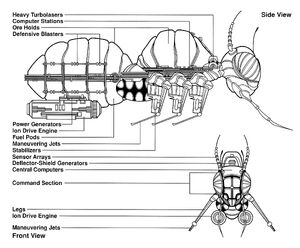
The schematics of an Ithullan ore hauler constructed out of a colossus wasp exoskeleton
A pair of large,[1] gunmetal-colored composite[3] eyes was located on the sides of the head, and it also had six antennae: two pairs on the top and the third, largest pair extending forward from the head's lower part.[1] The creature also had wings that reached several hundred meters in length,[2] and it could deliver a sting.[3] Its tan-colored exoskeleton[3] was thick enough to withstand blaster bolts[1] as well as the lack of atmospheric pressure in outer space and the high pressures involved in hyperspace travel.[2]
Colossus wasps were adapted for traveling through space and between star systems, not requiring the intake of any gases to survive and suffering no ill effects from lack of gravity. The wasps fed on stellar radiation[2] and cosmic rays[3] as well as on raw proto-materials present in asteroid fields,[2] including minerals. They also readily consumed any[3] creatures living on asteroids[1] that they encountered,[3] particularly space slugs,[2] which could reach lengths of several hundred meters.[7] Colossus wasps had a lifespan of several centuries,[1] and when the creatures died, their bodies frequently remained drifting in space, slowly breaking down over the course of many decades.[3]
Behavior[]
Preferring to search for food in asteroid fields,[2] colossus wasps migrated from world to world.[1] They spent eighteen of their homeworld Ithull's months offworld, returning during the remaining seven months to mate, bear young, and teach the newborn wasps the fundamentals of survival.[2]
History[]
The colossus wasp roamed the Stenness Node region and was specifically native to[2] the terrestrial[8] planet Ithull[2] of the Inner Rim's Airon sector.[9] It was the best-known creature of its homeworld,[2] and Gruna, who captained an Ithullan ore hauler starship[10] in 3999 BBY,[11] wore a golden pendant in the shape of a colossus wasp while on duty.[10] J9 worker drones, nearly two-meter-tall insectoid droids who were in existence millennia later, towered over their owners in a way that made them resemble colossus wasps.[12]
Colossus wasps in the galaxy[]
A miners' idea[]
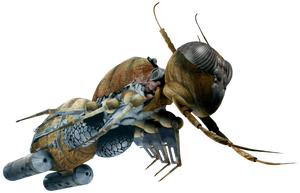
Nessie miners of the Stenness Node thought of using colossus wasp husks to construct Ithullan ore haulers (pictured).
More than four thousand years before the Galactic Civil War, the drifting bodies of dead colossus wasps became a source of inspiration for the miners[3] of the Nessies,[1] a group of twenty-five species inhabiting the Stenness Node.[13] Constantly having to adapt new starships for the transportation of[3] the mutonium[1] ore they collected to hyperspace terminals for dispersal into the wider galaxy, the miners realized that the colossus wasp exoskeletons were well-suited for transformation into cargo vessels.[3]
At one point, a group of enterprising bio-engineers discovered the resilience of the wasps' exoskeleton against the rigors of hyperspace travel. Over subsequent decades of research and application of the fields of biology, chemistry, and metallurgy, the engineers designed a theoretical model for a starship—the Ithullan ore hauler—that used the exoskeleton of the colossus wasp as its foundational structure. The model showed promising results in computer simulations, after which wasp hunters sought to obtain a carcass of the giant insect for use in constructing a prototype of the vessel. They soon learned that the colossus wasps could most frequently be encountered in asteroid fields and subsequently scoured the asteroids of the Stenness Node while looking for dead wasp specimens. Ultimately,[2] at some point by 3999 BBY[11] a successful prototype was built and tested, after which Nessie companies began the construction of the ships.[2]
Converting insect into starship[]
Initial work[]
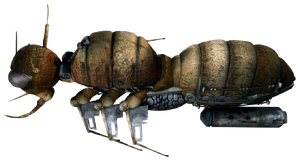
In order to transform a colossus wasp exoskeleton into an Ithullan ore hauler, the former was cleaned out and sectioned.
The appearance of the Ithullan ore haulers rendered them one of the most unique spacegoing craft in galactic history. The construction of each such vessel began with the messy process of cleaning out the innards of the colossus wasp. The internal organs were scraped out until only the hollow outer shell of the body remained, after which[3] the husk was sectioned to make room for[1] the interior framework, hydraulics,[10] and decks, and the ship's systems were installed. The complete refit that was done on the husk's interior led to it being difficult for an observer inside the ship to notice the unusual nature of the vessel,[3] although the inside surface of the exoskeleton itself could still be visible.[10]
The command bridge and the navigation and communications systems were all housed in the wasp's head.[3] Specifically, the command section was situated in the colossus wasp's eyes. The top of the head housed the central computers of the ship, and secondary computer stations were located in the space where the wasp's legs were connected to the thorax. The larger pair of the insect's antennae were converted into sensor arrays,[1] while the thin secondary antennae served as stabilizers. The upper legs of the exoskeleton were also outfitted with stabilizing wings[3] and maneuvering jets[1] for flight in planetary atmospheres, while the lower legs were left free for the purposes of landing the craft.[3]
Cargo space and defenses[]
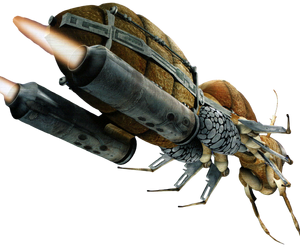
During the construction of an Ithullan ore hauler, engine units were attached to the outside of a colossus wasp's husk.
In order to maximize space available for holding ore, ion sublight engine and hyperdrive units were mounted outside the exoskeleton, along the lower abdomen section. The wasp's thorax was outfitted to hold the main ore holds, with additional space for storage available in the portions of the abdomen[3] not holding fuel pods, power generators, or drive control systems.[1] The completed ore hauler averaged between 1[3] and 1.1 kilometers in length,[1] and its cargo capacity was five hundred metric tons,[2] rivaling that of the largest Core Worlds bulk freighters.[1]
The colossus wasp's naturally tough exoskeleton was augmented by armor plating as well as deflector shields[3] for which the generators were located on the upper forward section of the thorax.[1] The passive defenses were complemented by two heavy turbolasers[2] situated on the thorax close to the wasp's head[1] and twelve defensive blasters[2] running along the entire length of the ship. To counteract the Ithullan ore haulers' defenses,[1] at some point by 3999 BBY,[11] the pirate captain Finhead Stonebone's engineers modified the high-powered plasma drills of a pair of stolen E-2 Asteroid Miner starships so that they could penetrate the hull of the ore haulers and therefore allow the pirates to steal the valuable ores transported by the vessels.[1]
Consequences for the wasps[]
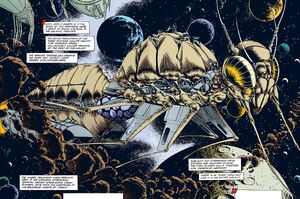
A colossus wasp–turned–Ithullan ore hauler in 3999 BBY
The entire process of both acquiring a colossus wasp husk and converting it into an Ithullan ore hauler was so costly that the vessels were only ever commissioned on an individual basis and not mass-produced. The fitting out of the ships was usually carried out by bio-engineers and bio-technicians who simultaneously conducted experiments on the interactions between the exoskeleton and the various chemicals and electronics involved in the conversion process.[2]
Although the companies that manufactured the ore haulers claimed that they only used naturally occurring husks of dead colossus wasps in the ships' manufacture,[2] it was well-known that certain mining colonies paid top price for the creatures' exoskeletons, leading to the emergence of colossus wasp poaching in asteroid fields—a dangerous enterprise to the hunters themselves due to the threat posed by the giant insects when they were defending themselves.[1] Several groups of scientists eventually came to suspect that at least a small percentage of colossus wasps were actively hunted and killed for their exoskeletons.[2] At some point, the use of the wasps in the manufacture of the Ithullan ore haulers had led the creatures to becoming scarce or possibly even extinct.[3]
Behind the scenes[]
- "My biggest fun was drawing this vast organic spacecraft. We were told if any of our designs got picked up for a film we'd get paid extra, but I'm still waiting! I mostly drew what I thought would look good and crossed my fingers, hoping they'd like it."
- ―David Roach
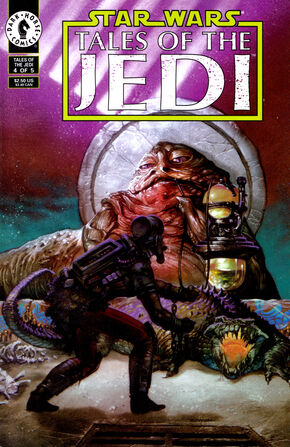
The colossus wasp was introduced in Tales of the Jedi 4.
The colossus wasp first appeared, in the form of an exoskeleton converted into an Ithullan ore hauler, in the fourth issue of Dark Horse Comics' Star Wars: Tales of the Jedi comic-book series. The issue was written by Tom Veitch and penciled by David Roach[10] and published on January 18, 1994.[15] Roach, who penciled two issues for the Tales of the Jedi series, later stated that the Ithullan ore hauler had been inspired by real-world hornets and that he found drawing the panels featuring the spacecraft to be the most enjoyable of all.[14]
The first installment of the A Guide to the Star Wars: Tales of the Jedi Universe series of articles written by Bob Cooper, published in the 1995 twenty-sixth issue of the Star Wars Insider magazine, provided the first clear spelling of the colossus wasp's name, using the capitalization "Colossus Wasp"[16] that was subsequently used by several other Star Wars sources.[13][17][18] Later, The Essential Guide to Vehicles and Vessels, a 1996 reference book authored by Bill Smith, was the first source to use the lower-case name "colossus wasp,"[1] which has since been used by the majority of the media referencing the creature.[2][3][4][5][6][17][18][19][20][21][22]
The book was also the first to identify colossus wasps by the name "Ithullian colossus wasp,"[1] although, beginning with 1998's Star Wars Encyclopedia,[17] the spelling of that name, as used in the more recent Star Wars sources, has shifted to "Ithullan colossus wasp."[6][18][20][21][22] In addition, The Essential Guide to Vehicles and Vessels in two instances incorrectly states that Captain Finhead Stonebone used his modified E-2 Asteroid Miner starships to carry out raids on colossus wasps themselves, as opposed to on the Ithullan ore haulers constructed out of the wasps' bodies.[1] The creature's name was misspelled as "Illuthan colossus wasp" in the fifty-fourth issue of De Agostini's The Official Star Wars Fact File magazine,[12] which was published around January 8, 2003.[23] The misspelling was repeated in the fifty-ninth issue of the magazine's 2014 re-make edition,[24] with that issue being released around February 25, 2015.[25]
Appearances[]
- Tales of the Jedi 4 (First appearance) (Appears as a corpse)
Sources[]
 "Straight from the Horse's Mouth: A Guide to the Star Wars: Tales of the Jedi Universe, Part 1" — Star Wars Insider 26
"Straight from the Horse's Mouth: A Guide to the Star Wars: Tales of the Jedi Universe, Part 1" — Star Wars Insider 26 "Straight from the Horse's Mouth: A Guide to the Star Wars: Tales of the Jedi Universe, Part 2" — Star Wars Insider 27
"Straight from the Horse's Mouth: A Guide to the Star Wars: Tales of the Jedi Universe, Part 2" — Star Wars Insider 27- The Essential Guide to Vehicles and Vessels (First identified as Ithullian colossus wasp)
- Tales of the Jedi Companion
- Star Wars Encyclopedia (First identified as Ithullan colossus wasp)
- Star Wars: Behind the Magic
- A Guide to the Star Wars Universe, Third Edition, Revised and Expanded
- The Official Star Wars Fact File 11 (PLA8, Planets of the Inner Rim)
- The Official Star Wars Fact File 54 (WOR2, J9 Worker Drone) (as Illuthan colossus wasp)
- The New Essential Guide to Vehicles and Vessels
- The Official Star Wars Fact File 114 (ORE1-2, Ithullan Ore Hauler)
- The Complete Star Wars Encyclopedia
- The Official Star Wars Fact File Part 59 (WOR2, J9 Worker Drone) (as Illuthan colossus wasp)
